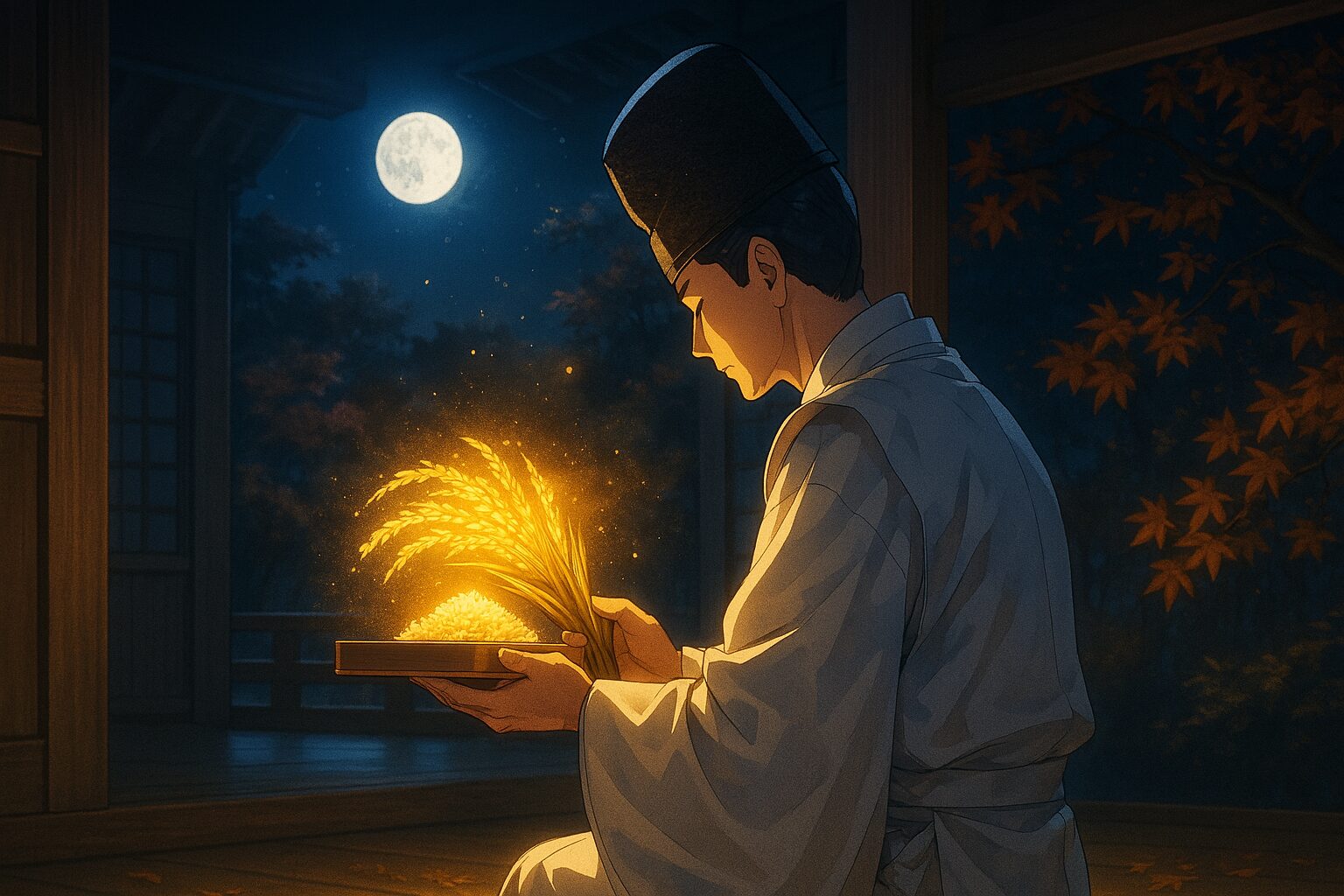Today, let me introduce you to the deep bond between “Rice”—the soul of Japan—the Emperor, and the land we live on. I will guide you into the abyss of Japanese culture that cannot be seen through superficial sightseeing.
1. Niinamesai: A Sacred Night to Renew the Soul
Historically, November 23rd was known as the “Niinamesai” (Festival of New Tasting). The etymology is fascinating: “Nii” means new grain, and “name” means to taste.
The Core of the Ritual
In this ritual, the Emperor does not simply celebrate the harvest. He offers the newly harvested rice of the year to the deities of heaven and earth, including Amaterasu Omikami (the Sun Goddess), to express gratitude. And here is the most crucial point: The Emperor himself consumes that new rice.
This is called “Shinjin Kyoshoku” (Communion of Kami and Man). By eating the same food as the gods, the Emperor absorbs spiritual power and prays for the peace of the nation and an abundant harvest. This is one of the most critical duties of the Emperor as the highest priest of Japan, a role that has continued since ancient times.
Why November 23rd?
When Japan used the lunar calendar, Niinamesai was held on the “Day of the Rabbit” in the 11th lunar month. However, when the Gregorian calendar was adopted in the Meiji era, the date was fixed to November 23rd from 1873 onwards to adjust for the seasonal gap.
Trivia: The Connection with Daijosai
The first Niinamesai performed by a new Emperor after his enthronement is specifically called “Daijosai” (Great Thanksgiving Festival). It is a once-in-a-lifetime, grand, and esoteric ritual to acquire the spiritual authority of the Emperor.
2. Rice is Not Just Food: Decoding the Depths of Japanese Culture
Through Niinamesai, we can see the special sentiment Japanese people hold toward “rice.” It is distinct from Western wheat culture or even other Asian rice cultures; it is a unique Japanese “Rice Faith.”
Identity as the “Land of Fresh Rice Ears”
In Japanese mythology, Japan is referred to as “Mizuho no Kuni.” This translates to “The Land where fresh rice ears ripen continuously.” In the myths, the Sun Goddess Amaterasu commanded her grandson, Ninigi-no-Mikoto, upon his descent to earth: “Grow the rice that exists in the heavens here on earth as well.”
For the Japanese, growing rice is not just agriculture; it is a mission from God. Niinamesai is like a completion report to the gods that this mission has been successfully accomplished for the year.
Transition to Labor Thanksgiving Day
In 1948, under the post-WWII occupation by GHQ, the name “Niinamesai” was removed from public holidays to separate Shinto from the state. Instead, “Labor Thanksgiving Day” was established, adopting concepts from the American Labor Day and Thanksgiving.
- Niinamesai: Gratitude to gods and joy of harvest (Vertical gratitude).
- Labor Thanksgiving Day: Respect for labor, celebrating production, and mutual gratitude among citizens (Horizontal gratitude).
Although the name has changed, the solemn Niinamesai ritual is still performed by the Emperor at the Imperial Palace on November 23rd. Shrines across the nation, including Ise Jingu, also hold festivals. The essence of the prayer remains inherited, regardless of the superficial name change.
3. A Question for Us Living in the Modern Age
In modern society, we buy neatly packaged rice and vegetables at supermarkets. It might be hard to feel the scent of the soil, the sweat of the farmers, or the presence of gods.
However, on this day of Niinamesai and Labor Thanksgiving, I would like to ask you:
“Can you imagine how much ‘life’ and ‘labor’ lies behind the meal you are eating today?”
The sunlight, the rain, the microorganisms in the soil, the farmer’s labor, the people involved in transport, and the person who cooked for you. All of these connect to form the single dish in front of you.
The phrase Japanese people say before eating, “Itadakimasu,” literally means “I humbly receive (lives).”
Today, why not eat your meal with a slightly special feeling?
What are the harvest festivals like in your country? I hope this ancient Japanese ritual reminds you of the “fundamental gratitude” we often forget in our busy modern lives.
References & Links
For those who wish to learn more deeply, please refer to the official information below.
- What’s Today’s Special Day Series – Check here for other Japanese anniversaries.
日本の秋は、単なる季節の変わり目ではありません。それは、大地からの恵みを受け取り、神々と人が「食」を通じて一つになる神聖な季節です。今日、11月23日。多くの現代日本人はこの日を「勤労感謝の日」として認識し、休日を楽しんでいます。しかし、この日の真の姿は、日本という国が2000年以上守り続けてきた、最も重要で、最も神秘的な宮中儀式の中に隠されています。
今日は、日本の魂である「米」と、天皇陛下、そして私たちが生きるこの土地との深い絆についてお話ししましょう。表層的な観光では決して見ることのできない、日本の深淵へご案内します。
1. 新嘗祭(Niinamesai):魂を更新する聖なる夜
11月23日は、元々「新嘗祭(にいなめさい・しんじょうさい)」と呼ばれる祭日でした。この言葉の語源は非常に興味深いものです。「新(にい)」は新しい穀物、「嘗(なめ)」は味わうことを意味します。
儀式の核心
この儀式において、天皇陛下は単に収穫を祝うのではありません。その年に収穫されたばかりの新米を、天照大御神(アマテラスオオミカミ)をはじめとする天神地祇(てんじんちぎ)にお供えし、神々に感謝を捧げます。そしてここからが最も重要な点ですが、陛下自らもその新米を食されます。
これを「神人共食(しんじんきょうしょく)」と呼びます。神様と同じものを食べることで、神の霊力を体内に取り込み、国家の安寧と五穀豊穣を祈るのです。これは古代から続く、日本の最高位の司祭としての天皇の最も重要な務めの一つです。
なぜ11月23日なのか?
かつて日本が旧暦(太陰太陽暦)を使っていた時代、新嘗祭は旧暦の11月の「卯の日」に行われていました。しかし、明治時代に太陽暦(グレゴリオ暦)が導入された際、そのままの日付では季節感がずれてしまうなどの理由から調整が行われ、明治6年(1873年)以降、11月23日に固定されました。
豆知識:大嘗祭(Daijosai)との関係
天皇が即位した後、初めて行われる新嘗祭のことを、特に「大嘗祭」と呼びます。これは一代に一度きりの、天皇としての霊威を身につけるためのさらに大規模で秘儀的な儀式となります。
2. 「米」は単なる食料ではない:日本文化の深層を読み解く
新嘗祭を通して見えてくるのは、日本人が「米」に対して抱いている特別な感情です。欧米の小麦文化や、他のアジア諸国の米文化とも少し異なる、日本独自の「稲作信仰」があります。
「瑞穂の国」というアイデンティティ
日本神話において、日本は「豊葦原千五百秋瑞穂国(とよあしはらのちいおあきのみずほのくに)」と呼ばれます。これは「みずみずしい稲穂が実る豊かな国」という意味です。神話の中で、天照大御神は孫のニニギノミコトが地上に降りる際、「天上界にある稲を、地上でも育てなさい」と命じました(斎庭の稲穂の神勅)。
つまり、日本人にとって米作りとは、単なる農業ではなく、神からのミッション(使命)なのです。新嘗祭は、そのミッションが今年も無事に達成されたことを報告する完了報告会のようなものです。
勤労感謝の日への変遷と現代の意義
1948年、第二次世界大戦後のGHQ占領下において、国家神道と政治を分離する目的から、「新嘗祭」という名称は公的な祝日名から外されました。代わりに制定されたのが、アメリカのLabor DayやThanksgiving Dayの概念を取り入れた「勤労感謝の日」です。
- 新嘗祭:神への感謝と収穫の喜び(垂直方向の感謝)
- 勤労感謝の日:勤労を尊び、生産を祝い、国民が互いに感謝しあう(水平方向の感謝)
名前は変わりましたが、今でも11月23日には宮中(皇居)で厳かに新嘗祭が執り行われています。また、伊勢神宮をはじめ全国の神社でも祭典が行われます。表面的な名称が変わっても、祈りの本質は変わることなく受け継がれているのです。
3. 現代を生きる私たちへの問いかけ
現代社会において、私たちはスーパーマーケットできれいにパック詰めされたお米や野菜を買います。そこには、土の匂いも、農家の汗も、ましてや神々の存在も感じにくいかもしれません。
しかし、この新嘗祭=勤労感謝の日に、私はあなたに問いかけたい。
「あなたが今日口にする食事の背後に、どれほどの『いのち』と『働き』があるか、想像できますか?」
太陽の光、雨の恵み、土壌の微生物、農家の労働、運送に関わる人々、そして料理を作ってくれた人。それら全てが繋がって、今あなたの目の前にある一皿になっています。
日本人が食事の前に手を合わせて言う言葉、「いただきます(Itadakimasu)」は、「(命を)頂戴します」という意味です。
今日は、少しだけ特別な気持ちで食事をしてみませんか?
あなたの国の収穫祭はどのようなものですか? 現代の忙しさの中で忘れがちな「根源的な感謝」を、この日本の古い儀式を通じて思い出していただければ幸いです。
関連情報・リンク
さらに深く知りたい方は、以下の公式情報も参考にしてください。
- What’s Today’s Special Day Series – 日本の他の記念日についてはこちらをご覧ください。



コメント